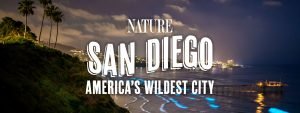By Abby Bernstein/Staff Writer
Published: November 5, 2024 at 12:44 am
San Diego: America’s Wildest City, PBS NATURE Main Art | © 2024 PBS
San Diego, California is known for many things, but generally not for its free-roaming wildlife.
But maybe that should be the case, according to the PBS documentary NATURE SAN DIEGO: AMERICA’S WILDEST CITY, which premieres on PBS Wednesday, November 6.
During the PBS portion of the Television Critics Association (TCA) summer 2024 press tour in Pasadena, Calif., San Diego is a somewhat less brutal city: AMERICA’S WILDEST CITY writer/director Nate Dappen and PBS NATURE executive producer Fred Kaufman sat down to talk about their work. A geographically but biologically epic film.
Dabin is particularly fascinated by the intersection between wild creatures and human beings, but he says he is fascinated by animals no matter what they do. “I love nature. I love all kinds of wildlife.”
However, “Our company, Day’s Edge, specializes in science and nature stories, but I would say eighty percent of our work is about people and our place on the planet, and what we’re doing to transform the planet. So, working on ‘SAN DIEGO: AMERICA’S WILDEST CITY’ was very important,” he said. It’s our second film about urban ecology, but we also produced a six-hour science series for PBS called HUMAN FOOTPRINT, which is about how humans are transforming the planet. We’re in the second season of that now as well so we’re particularly interested in stories about humanity and our role here, and how “We are attuned to nature, how we shape it, and how it shapes us.”
A study into why sharks approach shore found that this is related to where sewage pipes end up in the ocean. New microflora are created by the runoff, and collect around where the pipes meet the water. Microscopic species attract smaller fish, which attract larger fish, and so on, ultimately bringing in sharks.
“We don’t think about these things, do we?” Dabin says. “Our show The Human Footprint is about the unintended consequences of the way we shape the world. We’re not trying to increase sharks, we just have human waste, and the waste goes and turns into… [micro species]”.
Likewise, “We weren’t trying to bring the Ravens to San Diego; [cause] Hummingbirds are eaten by passers-by. We just change the environment, nature changes, and then we change how everything works.
Were Kaufman and PBS NATURE already thinking about a show like SAN DIEGO: AMERICA’S WILDEST CITY, or did Dappen come along and pitch it?
“He set it up,” Kaufman replies. “I didn’t have that in mind. And I couldn’t understand it. I was like, ‘Nate, why are we going to San Diego?’ Why not San Francisco? Why not Los Angeles? What about San Diego? I was just missing out. I didn’t understand So it definitely didn’t feel like a marquee city but I have to say, they came up with an outline of what they were going to do, and it was very convincing, and it’s in your movie [Dappen’s] You’ve said it’s the most biodiverse county in the United States, and that’s the line that sold me on it.
“It’s all from the outside – grunion spawn, this one [small fish] That come ashore to breed, killer whales, dolphins, roadrunners, hummingbirds – there was one thing after another. And then you stop and think about these ecosystems, these habitats — the mountains, the deserts, the city, the water — it’s like suddenly, I see that this represents a very diverse set of characters. But first I say: “Really?” Is this something we will do? What other ideas do you have?” Kaufman laughs.
“I think the answer to that question is it could be Los Angeles, it could be San Francisco, it could be New York, it could be Miami,” Dabin adds. “Obviously I wanted to learn more about San Diego, but I think the stories represent that. It’s a story about how The Shaping of Water. It’s a story about how the coast is shaped. It’s a story about urban sprawl. It’s a story about the way we think and look at it. And so, to me, it feels like I’ve watched a lot of life movies Urban Wilderness I think this does a good job of showing how humans shape the landscape, and how that impacts wildlife but it could be anywhere, right?
Kaufman agrees. “What we do is basically allocate the time and equipment to survival. Because if you go out, you get glimpses of everything, but give yourself a couple of weeks, and you get there in the morning at sunrise, and you might see some of these behaviors. It’s all accessible.” “All you have to do is be there and dedicate your time to watching it, because a lot of the shots, the sequences, the background and the context are places that are so accessible and lively, that everyone can watch it. People don’t take advantage of what they have in front of them.”
Dappen and Day’s Edge’s first urban wildlife film was 2022’s MIAMI WILD. “That was for the Smithsonian Channel,” Dappen explains. “It’s all about the urban environment in Miami. Miami is a unique place, because there are a lot of exotic species. Obviously there’s already a lot of biodiversity there, but pets that were released into the wild have been brought in, and now they’re thriving, everything From peacocks and parrots to snakes.
“So, it’s a story about migratory animals that are brought to a new land, and they have to make a living there, sometimes at the expense of some native species, but the native species also thrive. So, it’s about natural resilience in a landscape that humans have changed.”
Does camera monitoring change the behavior of any animal?
“For some species, that’s for sure; for other species, not at all,” says Dabin. “I think it helps to work with familiar animals. So, kind of how close you are. Like hummingbirds, if you sit in a blind, they won’t even know you’re there. Grips, if you sit in a curtain, they won’t even know you’re there. Ground squirrels, they just need to get used to you being there, but once they get used to you, they do what you want. They will run to you. I had ground squirrels crawling on me. They will treat you like a piece of the landscape.
Did Dabin and the team find any species they weren’t initially looking for?
“Roadrunner was a story that we didn’t originally plan to do. It wasn’t about a dolphin and an orca.
With the latter, Dappen points to footage obtained by SAN DIEGO: AMERICA’S WILDEST CITY of a pod of killer whales attacking a pod of dolphins. How did this catch Dabin’s attention?
“I was scrolling through death on Instagram, trying to sleep, and I was having a bad behavior on social media, and there were some people I follow who are passionate about marine mammals, and they were reposting stuff about all of this.
“I thought, ‘Oh, this isn’t something we can film.’ Then I saw it again somewhere else, and then again, and then again, and again, and there was all this hype, and they were talking about it on the local NPR station. When we realized what was happening, it became clear that this was a great story [should be covered]. We didn’t have a lot of big animals at the show.
On the other hand, an inability to film the right kind of activity led to the cancellation of a planned segment on rattlesnakes.
“The story of rattlesnakes is about invasive rats,” Dabin says. “When we build urban environments, mice come into the environments, and then we take out bird seed, because we love birds. And when birds feed on bird seed, they kick out the seeds.” [of the bird feeders]And then the mice come out. Then, this attracts rattlesnakes. So, it was just about the story we wanted to tell. We obtained all the footage, except for the predation event. Because the show had been running for so long, “among all the other stories we had, we had to cut something, and we cut that.”
Besides predation events, what types of behaviors does San Diego: America’s Violest City involve?
“We’re just looking for general natural history stories,” Dabben explains. “So, stories of survival, stories of thriving, and stories of challenge. With the diver, we filmed the crow doing these wonderful courtship behaviors, where they build their nests, mate, raise their young — they have this wonderful behavior.” Really where they put their babies on their backs, and then the little ones jump back and forth from mom to dad while the parent searches for food.
“We have hummingbirds raising their babies, and we have underground sequences. Ground squirrels build these enormous, complex networks of underground tunnels that are then used naturally by a bunch of different species — burrowing owls, alligator lizards, western frogs, tarantulas, millipedes.” So, we shot this sequence of this world right under our feet, which is a really important ecosystem that is invisible to us.
San Diego County contains a number of US military bases. Is there anything unique about the rules that creates a particular type of environment that invites or deters any particular type?
“I would say the military bases overall have been very positive for wildlife in San Diego,” Dabin answers. “[U.S. Marine Corps base] Camp Pendleton is a huge piece of land, and without it, there would only be a huge urban sprawl from Los Angeles all the way to Tijuana. So, it provides a tremendous base that has a bunch of endangered species, endangered species of rats, and they have a bunch of bison that live there, and tons of coyotes, and rattlesnakes, and all the different species that people will see in our film.
“There are other places where the development of military bases has created other kinds of challenges, but if I make a general statement, I think military bases have had a positive impact on wildlife, compared to the rest of urban development. Obviously things would be much more diverse and richer without all this.” Evolution, but I think, given where we are, Pendleton is the only thing preventing absolute sprawl from LA to T.J.
What has Dabin learned about how the most successful species thrive in these surroundings?
“For most of the types you see, it depends on how you define ‘success,’” Dabin answers. They are all very successful animals. It was a crow [previously] Very rare, they are now very abundant. Hummingbirds, there used to be only one or two species, but now there are four or five resident species. Crows did not exist, but crows are abundant now.
“I think the key to success is adapting to the world we live in. A lot of the changes we make are bad for some species and good for others. If you nest on large lakes, the tank is good for you. If you eat flower nectar, the feeders and flowers are good for you. So “I think if you’re able to adapt, you’re good. A lot of species are slow to change, and you won’t be able to really achieve that.”
What would Dabin and Kaufman want people to know more about this program?
“Dappen would like people to know that nature is happening all around us, all the time, and it’s wonderful, and you can find it. There are things we can do to make it better for them, which will make it better for us.”
Kaufman agrees. “I was going to say the exact same thing. The most important thing is that nature should not be viewed as something that is ‘out there somewhere’. It really is all around us, and it is truly amazing and wonderful. And if you stop and take the time and pay attention, you will see a lot of this for yourself.”
Follow us on Twitter at Task X
Like us on Facebook at ASSIGNMENT
Article source: Assignment
Article: PBS NATURE: SAN DIEGO: AMERICA’S WILDEST CITY: Director Nate Dabin and NATURE Executive Producer Fred Kaufman in a New Documentary – Exclusive Interview
Related to
Related posts:











